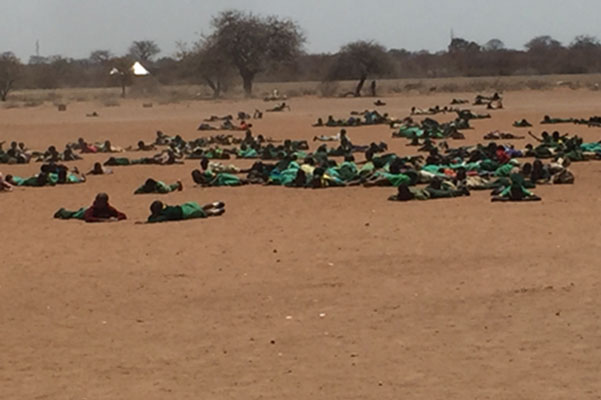
By Rex Mphisa
AT the sound of a drumbeat all 724 children at Langeni Primary School in Beitbridge take to the ground in unison.
In a flash, the children who a while ago were bundles of energy, running in all directions with their faces lit with chuckles and playful giggles, lie dead still.
Four and five-year-olds in preparatory Early Child Development (ECD) schemes, newcomers to the education world, are not outdone, they now know the survival drill.
The children, who hail from 10 surrounding villages, attentively take instructions meant to limit the effects of the ensuing “disaster”.
Guiding them are 100 students from the school’s disaster risk reduction committee (DRR) and together with the focal persons, they are in charge of the ongoing emergency drill.
Focal persons are teachers who manage this exercise called Ready To Act, a disaster management exercise aimed at cushioning impacts of possible disasters.
“We are under bees attack, lie still on the ground. We are under bees attack keep lying still,” the small, but clearly audible voices of some of the DRR committee repeat instructions.
- Chamisa under fire over US$120K donation
- Mavhunga puts DeMbare into Chibuku quarterfinals
- Pension funds bet on Cabora Bassa oilfields
- Councils defy govt fire tender directive
Keep Reading
Without the possible aid of loud hailers, a missing feature in their drill, the instructions are clear and adhered to religiously.
Ongoing is a drill in case the school is attacked by bees, something common in Zimbabwe and world over.
The children drawn from 1 211 homesteads surrounding their school Langeni, a relatively new learning centre near Tshapfuce Dip, 29km north of Beitbridge, have a variety of drills performed for various disasters.
“We have trained the children how to react to different disasters. There are different signals given to different types of disasters,” Protasio Hwereshenga, the headmaster at Langeni School said.
“We are ready for any disaster now at this school and in the villages.”
Albeit more refined, similar drills were done at the Old Nuli Primary School along the road to Chikwarakwara, where child enthusiasm produced classy acts.
Potential disasters at Langeni and Old Nuli Primary schools, along with 28 other schools in Beitbridge district are similar.
Ready To Act empowers the communities on disaster management equipping them both materially and mentally.
Save the Children, like it’s name, has a heavy bias towards children and concentrates in schools.
In Beitbridge schools experience wind storm in the past witnessed at both Langeni and Nuli.
Beitbridge, now almost a semi-desert due to repeated droughts and poor conservation practices coupled with animal overpopulation, is prone to disasters.
“We have heat waves, wild animals attacks, speeding cars, strong winds seasonal swollen streams, snake bites and even hunger as some of the disasters faced in this part of the country. We teach children on how to face these to cushion impact,” Miriam Mbira, a Grade 3 teacher and focal person at Old Nuli school said.
There are other focal persons at 60 schools in Matabeleland South’s Matobo and Beitbridge districts where thousands of children benefit from the programme funded by the European Union Humanitarian Aid.
Zimbabwe’s experience during Cyclone Idai in which thousands perished, were horrific, but these drills are certain to minimise impacts given that the natural defence system in human is being sharpened at an early childhood stage.
Mbira said the activities which include drama, poems and plays enthused children and as a teacher she feels this could be incorporated into their curriculum.
“Besides it creates a sense of alertness in them and children now report to school authorities anything they think can physically harm others,” said Mbira.
As part of their exercises children are educated on how to behave, walk or be their brothers’ keepers in the event of a disaster.
“The physically strong assist the physically challenged mates and teachers during drills carry the weak to impart that knowledge of duty boundless to learners,” Mbira said.
“The children activities towards disasters do not end at school, the children are in turn educating parents. People now know they must move to high ground during flooding and how to react to wild animals particularly elephants which are common here.”
Both Langeni and Old Nuli are near busy roads with speeding cars and children have been taught road safety measures.
Schools have been equipped with modern signage showing escape routes, assembly points.
They also have first aid kits and children are taught primary care of any casualties.
Children, like their elders in targeted areas, are educated on drawing maps of potentially hazardous areas and escape routes.
Old Nuli is located along a route used by cigarette smugglers illicitly moving thousands of tons of Zimbabwean finished tobacco products into South Africa. In August this year a speeding cigarette courier car overturned near the school killing seven people on the spot.
The children are also exposed to speeding vehiles smuggled through unofficial crossing points along the Limpopo River which race from authorities in numerous dirt roads leading from smuggling points.
“Hundreds of speeding cars pass here to the Limpopo River and pose danger to children whom we have now taught on how to cross any road,” Mbira said.
In Dite some 70km east of Beitbridge, Partson Sibanda chairs a village DRR which sits to plot reaction to disasters.
His committee comprising of three people per village is tasked with mapping and communicating early warning signs of possible hazards meets regularly to chart ways and mobilise resources.
Oxfam and the International Rescue Committee deal with the rural component and with the aid of modern technology villagers are assisted in coming up with maps of their areas.
The maps drawn with the aid of drones and experts deployed to educate villagers show escape routes.
“We also put detail on the capacity of villagers such that people know where to run or seek for help in the event of a disaster,” said Sibanda .
Residences of health workers and other local experts in various friends are marked on the maps which villagers are now able to read.
Village DRR have a database complete with phone contacts of all villagers with mobile phones to relay early warnings in the event of an oncoming disaster.
Inefficient phone network is a letdown and the villagers hoped mobile phone service providers would improve their transmission.
“There is a difference in how we react to disasters now than in the past. We are more informed and act with reasonable calm which is helpful,” Sibanda said in an interview.
“We know who needs help in the community where we have maps of our surroundings and methods of reaction have been taught to all villagers,” he said.
In Sibanda’s Dite area problems are similar to what is experienced in the entire Beitbridge East constituency were a channel along the Limpopo River’s course to the Indian Ocean subjects the area to strong winds.
Their proximity to Gonarezhou Transfrontier Park which encompasses the Kruger National Park and Gonarezhou Park in Mozambique and Zimbabwe exposes them to wildlife species of all types.
“We have set the times when children travel to school. Those from far leave school early and have been told how to behave in the presence of wildlife especially jumbos,” said Sibanda.
Other animals common in the areas are lions, leopards, jackals and other harmless species that will not attack humans.
Elephants are prevalent during harvests.
Sibanda said like the children’s mock drills, roll calls are done to check who could be missing when they gather at assembly points.
Dite’s DRR has also taken their role to commendable heights and advise villagers of types of house roofs suitable for their windy environment.
“We have recommended parapet roofs because we live in areas where strong winds are common,” said Sibanda.
Save The Children communications official Sophie Hamandishe said Ready To Act was started in 2018 in the two districts and training is done through local authorities and education stakeholder ministries.
“The Education Department and the Civil Protection Unit is involved in training villagers and learners. The data base of all villages and schools under spotlight is at the local authority,” she said.
For drought relief systems were now being put in place for mobile money transfers to villagers.
Villagers will be given cash to buy food from their local centres to cut food relief transport costs.
“At face level, Ready to Act programmes look unsophisticated but lessons learnt during the Cyclone Idai bring meaning to the subject certain to change and lower levels of damage in he event of disasters,” said Sibanda.
Chikwarakwara area 130km east of Beitbridge town is prone to flooding during the rainy seasons when the backlash of Limpopo’s entry into the Indian Ocean reaches the district.
Besides several of Beitbridge’s seasonal rivers pose threats to villagers and migrant workers who go to South Africa through unofficial entry points.
Other disasters common in Beit ridge are snake bites, scorpion stings and natural hazards like drought.










